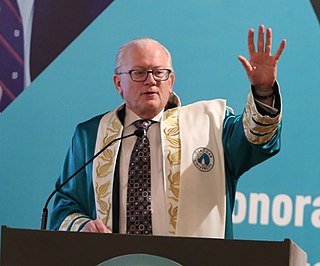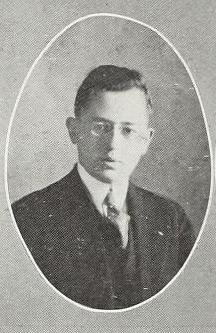Related Research Articles
Psychosis is a condition of the mind that results in difficulties determining what is real and what is not real. Symptoms may include delusions and hallucinations, among other features. Additional symptoms are incoherent speech and behavior that is inappropriate for a given situation. There may also be sleep problems, social withdrawal, lack of motivation, and difficulties carrying out daily activities. Psychosis can have serious adverse outcomes.

The hippocampus is a major component of the brain of humans and other vertebrates. Humans and other mammals have two hippocampi, one in each side of the brain. The hippocampus is part of the limbic system, and plays important roles in the consolidation of information from short-term memory to long-term memory, and in spatial memory that enables navigation. The hippocampus is located in the allocortex, with neural projections into the neocortex, in humans as well as other primates. The hippocampus, as the medial pallium, is a structure found in all vertebrates. In humans, it contains two main interlocking parts: the hippocampus proper, and the dentate gyrus.
Schizoaffective disorder is a mental disorder characterized by abnormal thought processes and an unstable mood. This diagnosis requires symptoms of both schizophrenia and a mood disorder: either bipolar disorder or depression. The main criterion is the presence of psychotic symptoms for at least two weeks without any mood symptoms. Schizoaffective disorder can often be misdiagnosed when the correct diagnosis may be psychotic depression, bipolar I disorder, schizophreniform disorder, or schizophrenia. This is a problem as treatment and prognosis differ greatly for most of these diagnoses.
George K. Aghajanian was an American psychiatrist who was Emeritus Foundations Fund Professor at the Yale School of Medicine, New Haven, Connecticut, in the Department of Psychiatry. He was a pioneer in the area of neuropharmacology. He also served as a member of the NARSAD Scientific Advisory Board.

Hippocampus anatomy describes the physical aspects and properties of the hippocampus, a neural structure in the medial temporal lobe of the brain. It has a distinctive, curved shape that has been likened to the sea-horse monster of Greek mythology and the ram's horns of Amun in Egyptian mythology. This general layout holds across the full range of mammalian species, from hedgehog to human, although the details vary. For example, in the rat, the two hippocampi look similar to a pair of bananas, joined at the stems. In primate brains, including humans, the portion of the hippocampus near the base of the temporal lobe is much broader than the part at the top. Due to the three-dimensional curvature of this structure, two-dimensional sections such as shown are commonly seen. Neuroimaging pictures can show a number of different shapes, depending on the angle and location of the cut.
Barbara A. Cornblatt is Professor of Psychiatry and Molecular Medicine at Hofstra Northwell School of Medicine. She is known for her research on serious mental disorders, with a specific focus on psychosis and schizophrenia. Her efforts to find treatments to help youth with mental illness led to the development of the Recognition and Prevention Program, which she founded in 1998.

Jeffrey Alan Lieberman is an American psychiatrist who specializes in schizophrenia and related psychoses and their associated neuroscience (biology) and pharmacological treatment. He was principal investigator for CATIE, the largest and longest independent study ever funded by the United States National Institute of Mental Health to examine existing pharmacotherapies for schizophrenia. He was president of the American Psychiatric Association from May 2013 to May 2014.
Karl Murdock Bowman was a pioneer in the study of psychiatry. From 1944 to 1946 he was the president of the American Psychiatric Association. His work in alcoholism, schizophrenia, and homosexuality is particularly often cited.
Dilip V. Jeste is an American geriatric neuropsychiatrist, who specializes in successful aging as well as schizophrenia and other psychotic disorders in older adults. He was senior associate dean for healthy aging and senior care, distinguished professor of psychiatry and neurosciences, Estelle and Edgar Levi Memorial Chair in Aging, director of the Sam and Rose Stein Institute for Research on Aging, and co-director of the IBM-UCSD Artificial Intelligence Center for Healthy Living at the University of California, San Diego School of Medicine. after serving for 36 years, he retired from UC San Diego on July 1, 2022.
S. Hossein Fatemi is an American-Iranian psychiatrist and neuroscientist, professor of psychiatry at the University of Minnesota.

Lori Altshuler was a professor at the University of California, Los Angeles (UCLA) Department of Psychiatry and Biobehavioral Sciences and held the Julia S. Gouw Endowed Chair for Mood Disorders. Altshuler was the Director of the UCLA Mood Disorders Research Program and the UCLA Women's Life Center, each being part of the Neuropsychiatric Hospital at UCLA.

Stephen Michael Stahl is an author and professor of psychiatry with expertise in psychopharmacology. He is currently a professor at the University of California, San Diego, and serves as Honorary Fellow in psychiatry department at the University of Cambridge. He is also the chairman of Neuroscience Education Institute (NEI) and Arbor Scientia Group.
F. Markus Leweke is a German psychiatrist and psychotherapist. He is a professor and Chair in Youth Depression Studies at the Brain and Mind Centre of the University of Sydney, Australia and a work group leader at the Central Institute of Mental Health in Mannheim, Germany.
Daniel R. Weinberger is a professor of psychiatry, neurology and neuroscience at Johns Hopkins University and Director and CEO of the Lieber Institute for Brain Development, which opened in 2011.
Carol A. Tamminga is an American psychiatrist and neuroscientist, focusing in treating psychotic illnesses, such as schizophrenia, psychotic bipolar disorder, and schizoaffective disorder, currently the Lou and Ellen McGinley Distinguished Chair in Psychiatric Research and the Chief of the Translational Neuroscience Division in Schizophrenia at University of Texas Southwestern Medical Center. She has been Chair of the Department of Psychiatry at UTSW since 2008. She is an Elected Fellow of the National Academy of Medicine. She serves on the advisory boards of the Brain and Behavioral Research Foundation and of the National Institute of Mental Health (NIMH). In 2011 she was awarded the Lieber Prize for Outstanding Achievement in Schizophrenia Research. Tamminga led a study examining whether giving Prozac to fetuses with Down syndrome would improve the functioning of their brains. In her attempt to confirm psychiatric diagnoses biologically, she found "biotypes" or "clusters." Her current research involves mechanisms underlying schizophrenia, especially its most prominent symptoms, psychosis and memory dysfunction.
Ming Tso Tsuang is an American psychiatrist and Distinguished Professor of Psychiatry at the University of California, San Diego. He is considered a pioneering researcher in the genetic epidemiology of schizophrenia and other severe mental disorders. Tsuang has authored and co-authored more than 600 publications and serves as founding and senior editor of the American Journal of Medical Genetics Part B.

Ganesan Venkatasubramanian is an Indian psychiatrist and clinician-scientist who works as a professor of psychiatry at the National Institute of Mental Health and Neurosciences, Bangalore (NIMHANS). His overarching research interest to learn the science that will facilitate a personalized approach to understand and treat severe mental disorders like schizophrenia. Venkatasubramanian is known for his studies in the fields of schizophrenia, transcranial Direct Current Stimulation (tDCS), brain imaging, neuroimmunology, neurometabolism and several other areas of biological psychiatry. The Council of Scientific and Industrial Research, the apex agency of the Government of India for scientific research, awarded him the Shanti Swarup Bhatnagar Prize for Science and Technology, one of the highest Indian science awards, for his contributions to medical sciences in 2018. He was also one of the collaborating scientists in the NIMHANS-IOB Bioinformatics and Proteomics laboratory of the Institute of Bioinformatics (IOB) in Bangalore and NIMHANS. Besides, he is an adjunct faculty at the Centre for Brain Research (CBR) in Bangalore.

Jacob Sergi Kasanin (1897-1946) was a Russian born, American trained psychiatrist who introduced the term acute schizoaffective psychoses in 1933. He was known as Yasha to those close to him. He was born in Slavgorod, on 11 May 1897, and moved to the United States in 1915. He graduated from the University of Michigan with a Bachelor of Science in 1919, Doctor of Medicine in 1921 and a Master of Science in Public health in 1926.
Joseph Thomas Coyle Jr. is an American psychiatrist and neuroscientist that is known for his work on the neurobiology of mental illness, more specifically on schizophrenia. He is currently the Eben S. Draper Chair of Psychiatry and Neuroscience at Harvard Medical School in Boston, Massachusetts. He was President of the Society of Neuroscience from 1991–1992, and also the president of the American College of Neuropsychopharmacology in 2001. He is a member of the Institute of Medicine.
Staci Ann Gruber is an Associate Professor of Psychiatry at Harvard Medical School and Director of the Cognitive and Clinical Neuroimaging Core (CCNC) and the Marijuana Investigation for Neuroscientific Discovery (MIND) Program. She is known for her work examining substance use and psychiatric conditions using advanced neuroimaging techniques and measures of cognitive performance.
References
- ↑ "Dolores Malaspina, M.D., M.S., MSPH". Brain and Behavior Research Foundation. 10 March 2017. Retrieved 3 October 2021.
- 1 2 "Psychiatry Residency Program Visiting Professor Dolores Malaspina, MD". New Bridge Medical Center. Retrieved 3 October 2021.
- ↑ Marantz, Andrew (September 9, 2013). "Reality Star". The New Yorker. Retrieved 17 October 2022.
- ↑ Schobel, Scott A.; Lewandowski, Nicole M.; Corcoran, Cheryl M.; Moore, Holly; Malaspina, Dolores; Small, Scott A. (September 2009). "Differential Targeting of the CA1 Subfield of the Hippocampal Formation by Schizophrenia and Related Psychotic Disorders". Archives of General Psychiatry. 66 (9): 938–946. doi:10.1001/archgenpsychiatry.2009.115. PMC 2797730 . PMID 19736350.